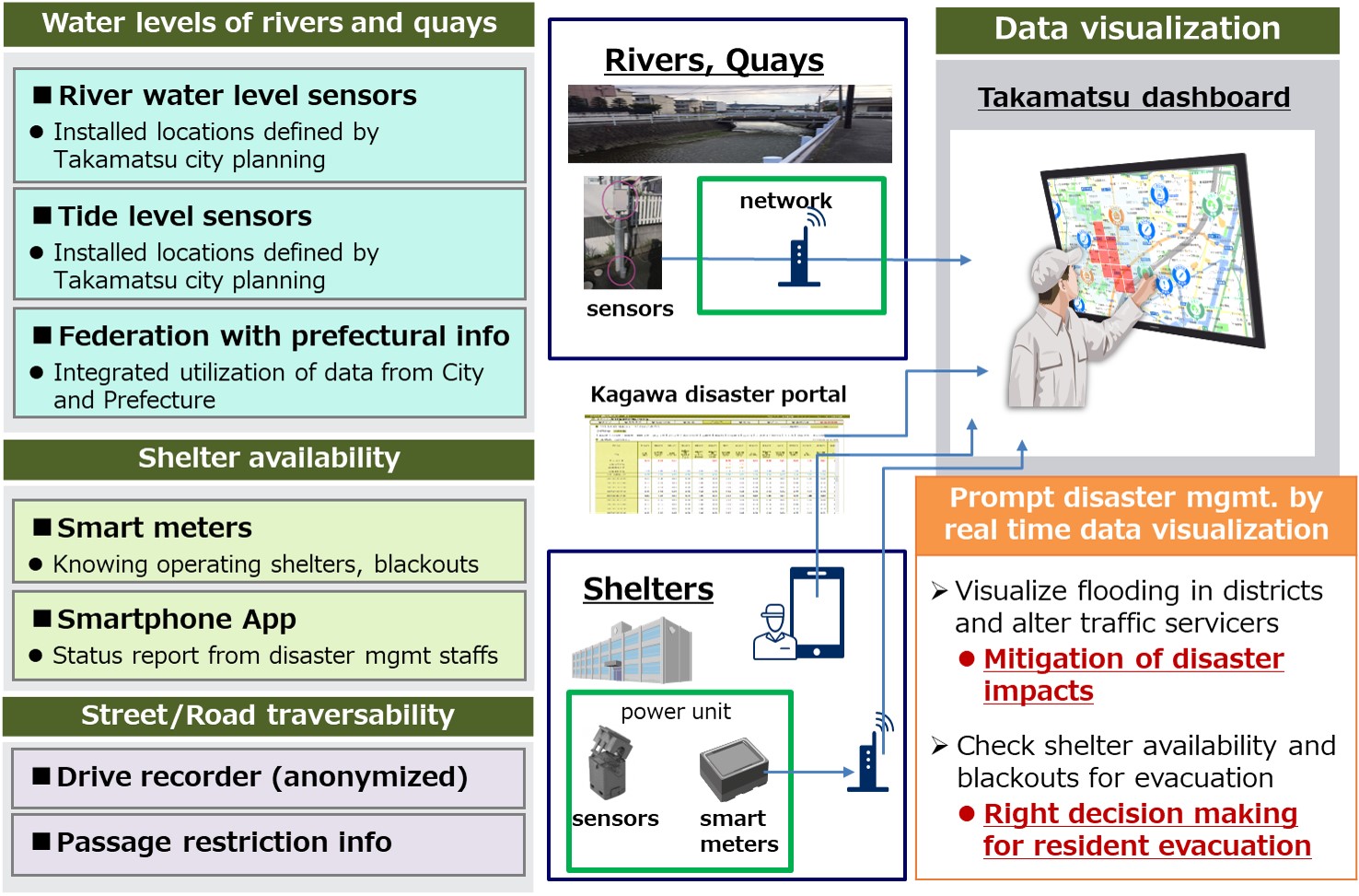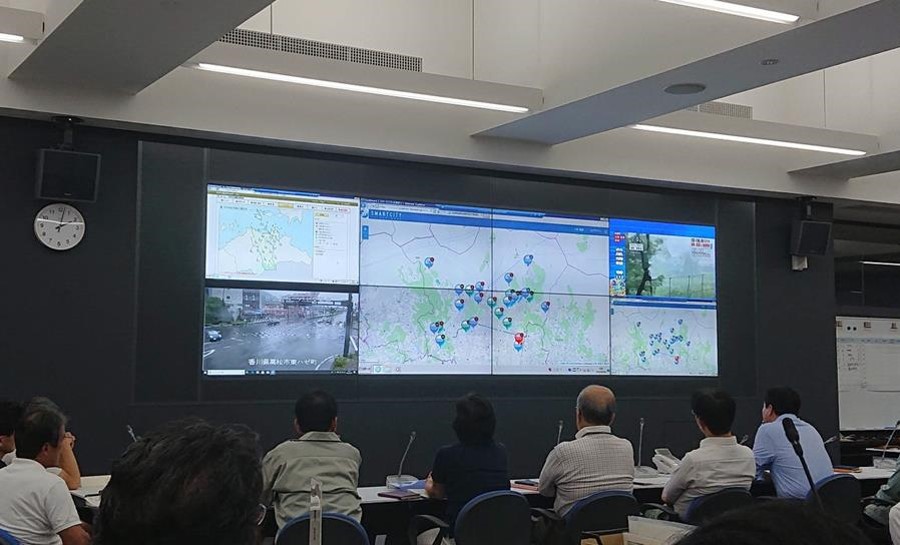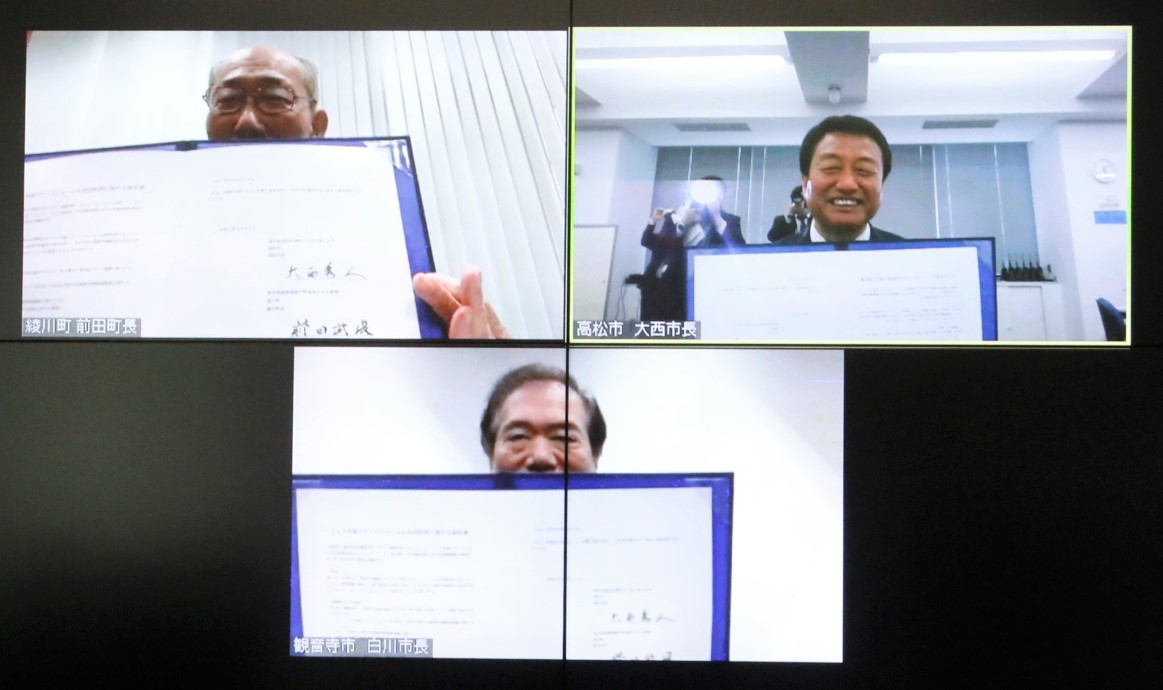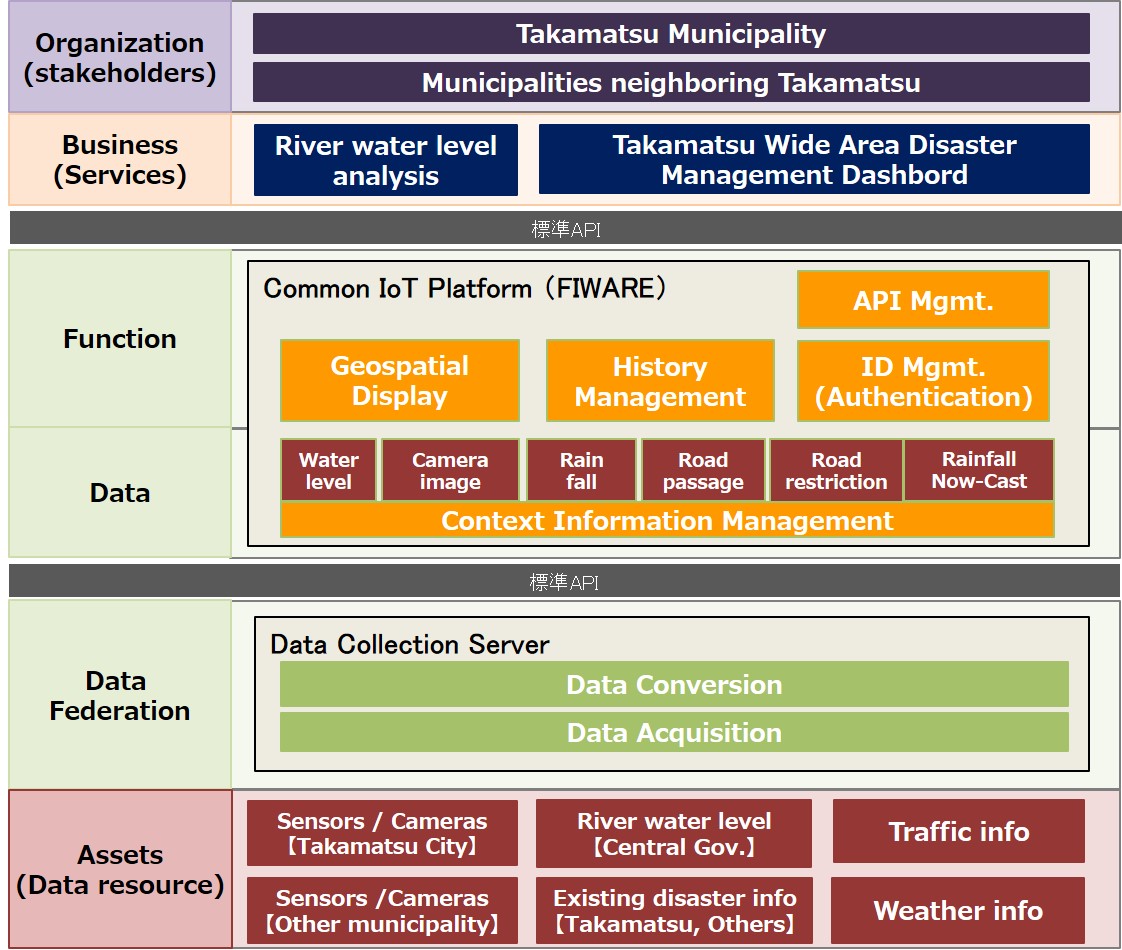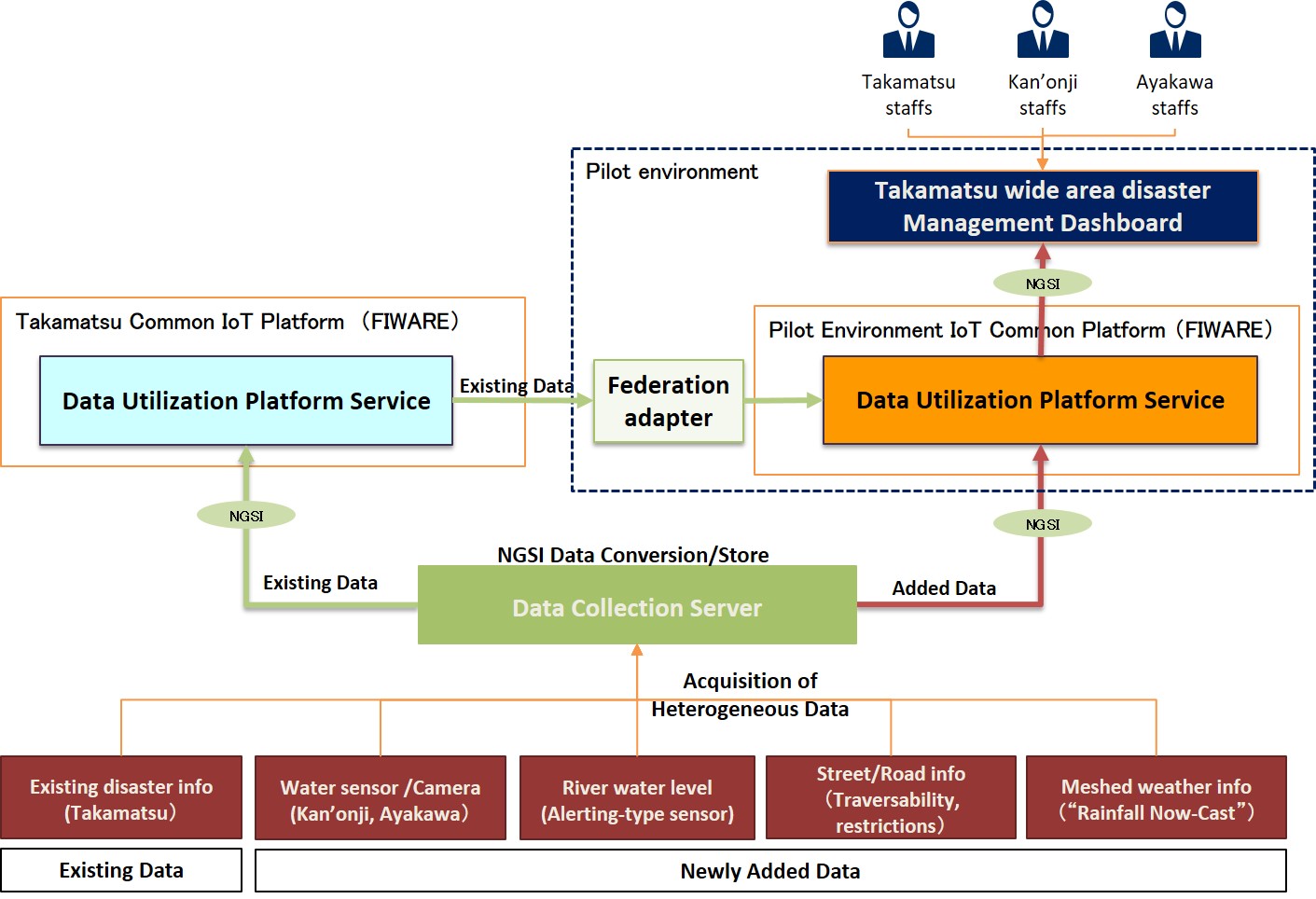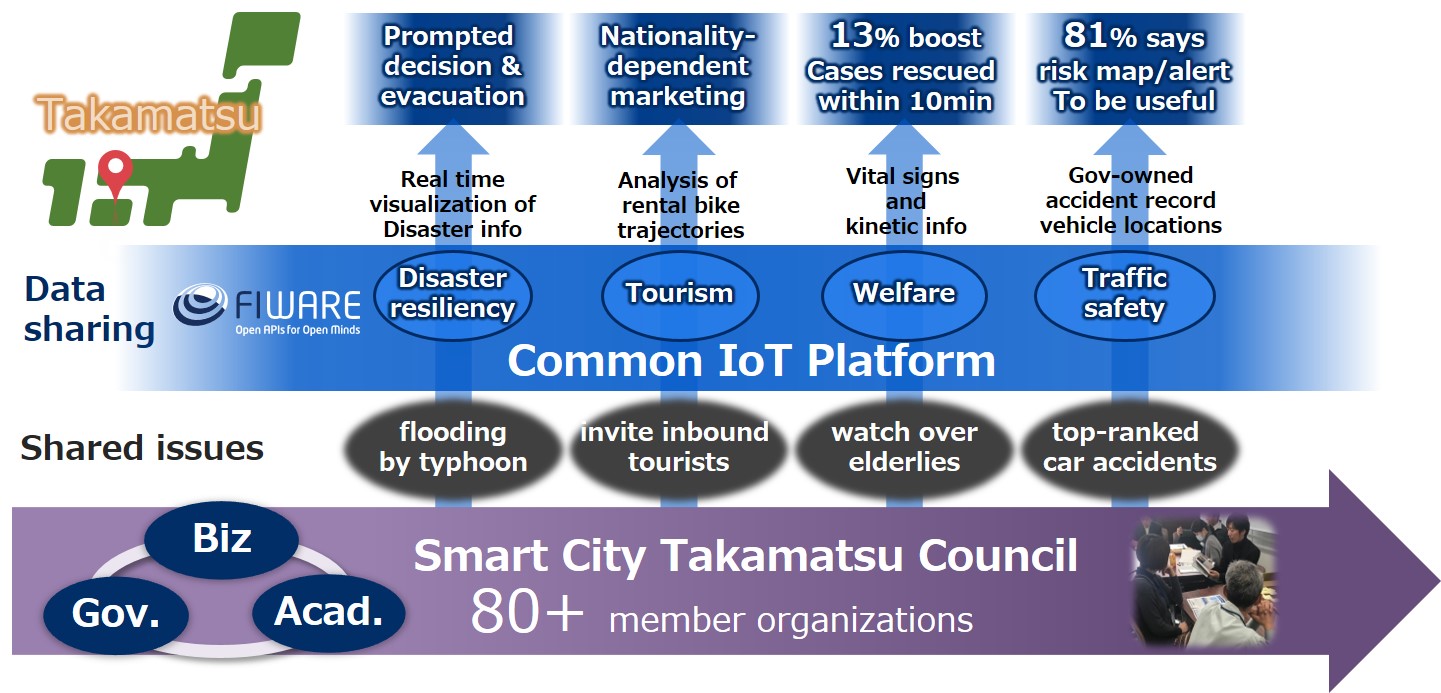Challenge & Context
Takamatsu City is the capital of Kagawa Prefecture (Japan), and it is actively promoting its Smart City policy. Setting the target to become “a city of sustainable growth”, the city is aiming to meet specific regional challenges and stimulating regional economic growth via digital innovation through collection and sharing/re-use of a wide range of Internet of Things (IoT) data. One of the first-year initiatives promoted by the city is the disaster resilience initiative toward a safe and secure community, by working on real-time understanding of risk and damage situations, thereby guiding citizens to early and appropriate evacuation. Disaster resilience is a common challenge in many Japanese municipalities as the whole country faces a constant risk of typhoons and downpours. Moreover, climate change is making such disasters even more severe and more unpredictable. Meanwhile, the way in which such emergencies are handled, has to be innovated with Japan’s elderly population needing assistance. Such urgencies have been showing rapid increase and, throughout 2020, needed to simultaneously mitigate the risks associated with the COVID-19 pandemic.
Looking at past experiences, a typhoon that hit Takamatsu in 2004, caused serious damage (with a level of once-in-50-years) when its passage coincided with high-tide hours. This coincidence resulted in a reverse water flow into the local rivers and the flood reached 2km inland from the shore; the flooded area, including the central district of the city along the harbour, amounting to 980 hectares. 15,000 buildings were damaged and two citizens lost their lives. Takamatsu is the core city of political matters and business on Shikoku Island, one of the four major islands constituting Japan, collecting many regional hub branch offices of central government and large companies. The entire city was brought to a standstill by the flood.
Since the typhoon hit the city in 2004, city staff has been dispatching to Takamatsu harbour their water level reports for better water control every time a typhoon is about to come. The City Managers of Takamatsu City explained how therefore educated decisions were taken in a critical situation: “We reported the sea level at the quay every 30 minutes, we teamed up in pairs and wore life jackets, in blustering wind and pouring rain”.
Saving the lives of citizens is the top priority mission of a municipality. Now, when there is a high disaster risk, the city sets up its emergency management office straight away and city staff control the field and alerts. City staff have ample authority to run and enforce evacuation orders before the danger hits the community. Noting that speed and precision are key success factors in emergency situations, Takamatsu City made disaster management a priority when it started its initiative “Smart City Takamatsu”.
Solution
Takamatsu City has built an IoT-based visualization system for its disaster management. The system integrates a wide selection of information and visualizes the real-time emergency situation on the integrated dashboard. Through such a solution, it is now possible to mitigate disaster damages by proactively delivering flood sandbags and notifying the local traffic service providers of the emergency situation. For the sake of residents, the municipality can make a quick and timely decision when ordering or advising evacuation.
Real-time info on water level
Water level of rivers and canals, tide level at quays, and water level at underpasses are monitored through installed water-level sensors. There are also video cameras installed to support a better understanding of critical situations in real-time. Additionally, disaster information coming from the Prefecture (more macroscopic) is integrated.
Rainfall forecast
30-minute period rainfall forecast for geographical meshes of 1km2, updated every 5 minutes, is available via a service called “Rainfall Now-Cast”, offered by the central government (Japan Meteorological Agency).
Traversability of streets/roads
Closure announcement issued by public authorities: a private service based on GPS-based vehicle passage counting is integrated to reveal the real-time traversability for vehicles.
Evacuation shelter’s situation
Starting of shelters is sensed via smart meter signals. The signals are also used to evaluate the probability of blackouts. Using smartphone apps, the city staff also report the shelters’ situation and information of evacuees.
Figure 1 . Takamatsu City’s Disaster Management Solution
In order to build this solution, Takamatsu City installed water level sensors along rivers and quays, at the locations known for high flood probability, as demonstrated in their project executed in 2019. The sensors were also installed at underpasses, as during the typhoon in 2004 a flooded underpass resulted in the death of a civilian. This way, the municipality can manage rivers and canals that are small and tend to flood easily and quickly when concentrated downfalls hit. Video cameras were installed to create an additional insight into the overall situation beside the water level information.
The new sensors-based solution renders the previous regular city staff patrols unnecessary thanks to the available real-time and fine-grained diagnosis level of the local rivers. Furthermore, it is no longer required for the city staff to manually analyse various information with all required information visualized on the geographical map of the integrated dashboard. The system dramatically reduces the time required for information collection and analysis and enables quick and timely actions for handling emergency situations. Also, it is now possible to dispatch the city staff to the pinpointed risk locations, thereby achieving an efficient dispatch of human resources.
Visualized information such as water levels and tide levels are additionally available to citizens via the city’s portal “Open Data Takamatsu”. The idea behind this is to provide citizens with the necessary information should they have to make life-saving decisions: it can be seen as a decision support tool for citizens when they are about to take their own actions for saving their lives.
Figure 2 . Dashboard in the Disaster Management Center
In 2020, two adjacent municipalities, Kan’onji City and Ayagawa Town decided for a shared use of the Common IoT Platform of Takamatsu City by signing the collaboration agreement on March 27, 2020, to form a wide-area disaster resilience initiative. This came as a natural consequence of the common understanding that utilizing IoT data generated from a wider area provides more reliable and better insights. At the same time, such a wide-area collaboration also benefits residents who commute across municipality boundaries every day.
Figure 3 . Mayors signing agreement for the Wide-rea Disaster Management collaboration
While building its Common IoT Platform, Takamatsu City invited regional companies and organizations to form the “Smart City Takamatsu Council”, which is aimed at solving region-specific challenges such as economic vitalization and safety and security through a collaboration of public, business and academic stakeholders. This council consists of working groups created for specific regional challenges. Such problem-focused approach has so far been more successful in generating tangible outcomes for the community than a tech-first approach.
How it works
Takamatsu City implemented a data-sharing-oriented Common IoT Platform based on FIWARE technology. It enables the collection, storing and analysis of data from multiple domains and sources, hence leading to a significantly wider problem solving approach in the community as well as the creation of regional innovations.
Figure 4 . System Architecture of Wide-Area Disaster Management Service
Figure 4 shows the system architecture for the Wide-Area Disaster Management Service based on a heterogeneous system. In the initial phase, water-level sensor data acquired by the municipal governments together with data published by existing external systems (e.g. for water level, tide level, traffic and weather — belonging to the Asset Layer in the diagram), are integrated and stored in the Common IoT Platform via the data collection server belonging to the “Data Federation Layer”. This converts data from heterogeneous data resources into a unified and standard format (i.e. NGSI) in order to enable data sharing among different applications, then being utilized for disaster prevention/management.
In this Common IoT Platform, stored and/or acquired data are managed in a unified manner by the context management function and provided to the data user in the form of a standard API. The system as well offers API management services, geospatial mapping, history management and ID management (authentication and approval).
The FIWARE Generic Enablers (GEs) used are:
- Orion Context Broker
Central data orchestration tool of the platform; - STH-Comet
Manages aggregated time-series IoT information for the in-time evolution of context data registered in Orion Context Broker; - Cygnus
Plays the role of the connector between Orion Context Broker and STH-Comet.
With the business layer, two visualization services were built allowing a precise understanding of disaster-related information as well as information-sharing among multiple municipalities.
Takamatsu Wide Area Disaster Management Dashboard
Managing aggregated time-series IoT information of context data registered in Orion Context Broker.
Water Level Analysis
Providing trend information on the river/canal situation.
Figure 5 . System Layout of Wide-Area Disaster Management Service for Takamatsu, Kan’onji and Ayagawa municipalities
Figure 5 shows the actual system layout based on the aforementioned architecture. With the implementation of the data collection server, the global standard, NGSIv2, was adopted as the standard API. Data acquired by this server were converted into NGSIv2, following the NGSI data models defined for respective datasets, and then integrated to or stored into the Common IoT Platform to be consecutively provided to Takamatsu Wide-Area Disaster Management Dashboard and Water Level Analysis via NGSIv2 API. The disaster management service is now under expansion including the AI-based river water level prediction. Every time the water level increases for small rivers as a result of downpour takes place suddenly, experimentation gets started to determine the appropriate time interval for data acquisition in order to obtain satisfactory precision of the flood risk forecast.
Benefits & Impact
The IoT-based Wide-rea Disaster Management provides benefits in multiple areas:
- higher-precision and real.-time understanding of the situation whilst reducing risks for city staff on patrol;
- more appropriate and timely decision making for evacuation order announcements to residents;
- traffic guidance based on closed/dangerous road point information;
- efficient operation and capacity management of shelters (particularly during the COVID-19 pandemic);
- enhanced accuracy of risk assessment as well as commuter-friendly information services enabled by cross-municipality collaboration.
The City Manager was extremely satisfied to have obtained citizen collaboration in a very straightforward manner with regard to the introduction of digital services and thus help disaster management to further guarantee the safety of citizens. How does this work in practice? For instance, citizens express their support for the installation of video cameras along rivers during town meetings to help develop an understanding for the planned smart city initiatives. Referring to the collaboration between cities, the wide-area disaster management turns out to stimulate regional businesses which grow at the same time interest in working on smart city activities also in other domains.
With the Smart City Takamatsu Council established at the beginning of their smart city initiative in Takamatsu in March, 2018, local business and academia got invited to also join and collaborate for the realization of a smart city in order to vitalize the regional economy and solve region-specific problems. The council started with six member organizations to then grow to more than 80 members by September 2020. Also regional businesses are now seeing opportunities to utilize the Common IoT Platform that Takamatsu City introduced. “In the past, with regard to city innovation programs, the private sector tended to rely on government budget allocation to start business activities. This has changed over time and private businesses have been starting to make their own investments. Meanwhile, also university students began to use the platform for experimentation. We are, thus, indeed feeling that the public-private-academia collaboration in this city has started to expand”, analyses Mr. Osamu Goto, a staff member of NEC Shikoku Branch Office, who works for the smart city initiative in Takamatsu in collaboration with the city government.
With a decreasing birth rate and an aging population, many regional cities in Japan are facing the risk of losing vitality. It is becoming more and more difficult to maintain the quality of public services just by relying on manpower alone. Boosting service efficiency is now indispensable. The smart city initiative of Takamatsu, which was the first city in Japan to introduce FIWARE, has been moving forward to fully leverage IoT. It has now become a highly visible reference in Japan attracting the attention of many other Japanese municipalities.
Added value through FIWARE
The city started using the FIWARE-based Common IoT Platform also in other domains such as tourism, elderly-care/welfare and traffic safety and has been demonstrating positive outcomes:
Tourism
Renal bicycle trajectory data revealed that visitors’ interests depend on their nationality. The city is utilizing such knowledge for marketing purposes and the development of new tourism assets to further enhance visitor experiences;
Elderly-care/welfare
Improving the care-taking service for elderly people living alone. In emergency situations, the cases rescued within 10 minutes increased by 13%;
Traffic safety
Anticipating the locations with high potential for accidents, drivers are notified and warned in real-time.The service received 81% positive feedbacks from drivers.
Figure 6 . Outcomes of smart city initiative in Takamatsu leveraging Common IoT Platform and the regional collaboration ecosystem
Such quick wins in demonstrating visible outcomes are of course attributed to the adoption of FIWARE. At the same time, the regional stakeholders’ collaboration mechanism of the Smart City Takamatsu Council is playing an indispensable role. Its working group activities are selected following the regional prioritization of problems to be addressed. This problem-solving approach of a public-private-academia ecosystem is indeed the core of well-functioning smart city activities. Meanwhile, the city has been deploying the aforementioned services in an incremental way year by year, which makes the initiative consistent with the financial budget available. Such flexibility and scalability are further important value-adds enabled by FIWARE.
Other cities in Japan, Kakogawa and Toyama, are also using FIWARE. These communities have defined their own priorities and focus points, as well as the strategy for how to nurture local smart city ecosystems, and are becoming the leading practice reference of Japanese smart cities.
Next Steps
Triggered by the successful cross-municipality collaboration in disaster management, Takamatsu City, being the core municipality for the regional collaboration defined by the central government, is currently planning to invite more cities to collaborate to make the disaster management services even better and more comprehensive.
Meanwhile, the Japanese government has shared a vision of disaster management to harmonize “public help, mutual help and self-help” leveraging cross-domain utilization of digital innovations. It is expected that the frontrunner use case of the Takamatsu region will further expand over domains and enhance collaboration to become the reference for how such a vision can be realized.
References
- NEC Wisdom article, June 25, 2020 (in Japanese)
- Business Summary of Smart City Takamatsu (in Japanese)
- Smart City TAKAMATSU, FIWARE Global Summit, May 8, 2018 (in English)
- Cabinet Office, “How to Use Smart City Reference Architecture, Installation Guidebook”, Case Study-2, p.48, July 20, 2020 (in English)

